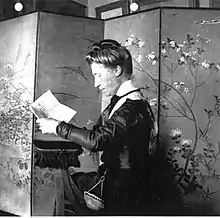Lady Eliza D'Oyly Burroughs | |
|---|---|
 | |
| Born | 9 May 1849 |
| Died | 1 February 1908 (aged 58) |
.jpg.webp)
Lady Eliza D'Oyly Traill-Burroughs (née Geddes, 9 May 1849 – 1 February 1908) was a British archaeologist.[1] She described the discovery of Taversöe Tuick chambered cairn on the island of Rousay, Orkney, Scotland in May 1898 in her journal, which was published and discussed in Proceedings of the Society of Antiquaries of Scotland in 1985.[2][3]
She was born in 1849 in Leamington Priors, Warwickshire and grew up in the Meadows in Edinburgh.[3] Eliza was the daughter of Colonel William Geddes of the Bengal Horse Artillery and his wife Emma. Aged 21, she married Lt-General Sir Frederick Traill-Burroughs (1831-1905) on 4 June 1870. He had inherited an estate on Rousay, Orkney, to which the couple moved.[4] Eliza's interest in art, politics, and charity meant she was strongly involved in life on Orkney.[1] In 1893, work began building their home, Trumland House, which is where the Taversoe Tuick Chambered Cairn was discovered in 1898.[5]
Eliza wrote a report on Taversoe Tuick, which provides a detailed chronological overview of the events leading up to the discovery and the excavation of the cairn, accompanied by sketches, plans, and measurements. Interestingly, Eliza signed off her report with 'Veronica' and not with her own name.[3] In her later life, Eliza described the excavation as '...one of the most interesting events of my life: a pursuit I can cordially recommend to anyone in search of excitement!'[1] The findings of the excavation were published in 1903 by Sir William Turner, but Eliza was only credited for her illustrations.[6]
Eliza's Taversoe Tuick report was transcribed and published in 1987 by Diana Reynolds.[2] Eliza was commended for her standard of recording and contribution to archaeological research in Scotland, as her archaeological views continue to help archaeologists understand the site's chronology.[3]

There is a memorial stone in St Magnus Cathedral, Kirkwall, with the words "Erected in loving memory of Sir Frederick W. Traill-Burroughs ... Also to the memory of his wife Lady Eliza Doyly Traill Burroughs, his faithful companion through storm and sunshine ... Erected by her devoted niece Lady Sinclair of Dunbeath".
References
- 1 2 3 Scholma-Mason, Nela (22 April 2018). "Lady Eliza D'Oyly Burroughs". TrowelBlazers. Retrieved 17 August 2023.
- 1 2 Reynolds, Diana (1987). "'How we found a tumulus' a story of the Orkney Islands - the journal of Lady Burroughs". Proceedings of the Society of Antiquaries of Scotland. 115: 115–124. ISSN 2056-743X. Retrieved 1 February 2021.
- 1 2 3 4 Scholma-Mason, Nela M. A. (23 August 2021). "Eliza D'Oyly Traill Burroughs (1849–1908)". Proceedings of the Society of Antiquaries of Scotland. 150: 279–299. doi:10.9750/PSAS.150.1317. ISSN 2056-743X.
- ↑ Vibart, Henry Meredith (1912). . Dictionary of National Biography (2nd supplement). Vol. 1. p. 273.
- ↑ "Trumland House". Rousay Remembered. 7 May 2020. Retrieved 17 August 2023.
- ↑ Turner, William (30 November 1903). "An Account of a Chambered Cairn and Cremation Cists at Taversoe Tuick, near Trumland House, in the Island of Rousay, Orkney, excavated by Lieut. General Traill Burroughs, C.B., of Rousay, in 1898". Proceedings of the Society of Antiquaries of Scotland. 37: 73–82. doi:10.9750/PSAS.037.73.82. ISSN 2056-743X.